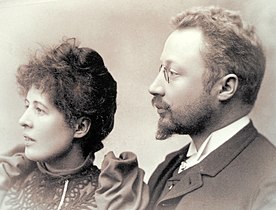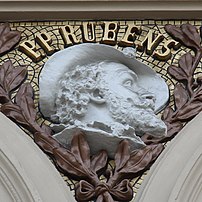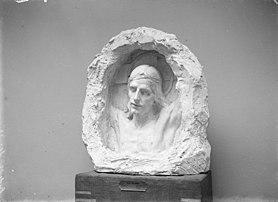| Ville Vallgren | |
|---|---|
 Ville Vallgren in 1930 Ville Vallgren in 1930 | |
| Born | (1855-12-15)15 December 1855 Porvoo, Grand Duchy of Finland, Russian Empire (now Finland) |
| Died | 13 October 1940(1940-10-13) (aged 84) Helsinki, Finland |
| Nationality | Finnish |
| Known for | Sculpture |
Carl Wilhelm "Ville" Vallgren (15 December 1855 – 13 October 1940) was a Finnish sculptor. His best-known work is the statue Havis Amanda in Helsinki.
Biography

He was born in Porvoo, and long resident in Paris, whither he went in 1878, after studying architecture in the Helsinki Polytechnic. He entered the École des Beaux-Arts, studied under Cavelier.
In 1882 he married Swedish sculptor Antoinette Råström with whom he worked together. She died in 1911. The same year he married French opera singer and painter Madeleine Imbert-Rohan, but the marriage was rocky from the start and ended only two years later. That year in 1913 he moved back to Finland where he met and married his third wife, Finnish sculptor Viivi Paarmio.
He died on 13 October 1940 in Helsinki, and he was buried in Porvoo.
-
 Portrait of Ville Vallgren, Ernst Josephson, 1880
Portrait of Ville Vallgren, Ernst Josephson, 1880
-
 Portrait photograph taken in 1891
Portrait photograph taken in 1891
-
 Working on the statue Echo with his sculptor wife Antoinette, Albert Edelfelt, 1886
Working on the statue Echo with his sculptor wife Antoinette, Albert Edelfelt, 1886
-
 Ville Vallgren and his wife Antoinette in 1903
Ville Vallgren and his wife Antoinette in 1903
-
 With his third wife, also sculptor Viivi in 1930
With his third wife, also sculptor Viivi in 1930
-
 His grave, with a crying angel sculpted by Viivi
His grave, with a crying angel sculpted by Viivi
Works
His mirrors, figurines, lamp stands, urns, and candelabra established his reputation as a decorative artist. Of his statues and portraits, several are in New York City in the Vanderbilt collection, notably Death and Resurrection and A Breton Girl. His works in Finland include a Mariatta, in the Imperial Castle, and a Christ in the National Museum at Helsinki. The marble group Maternity is in the Museum of Arras, and a bronze statuette, Youth, in the Berlin National Gallery.
-
 Echo, 1887
Echo, 1887
-
 Main facade of Ateneum Art Museum worked on by multiple artists, with medallion sculptures by Vallgren, 1887
Main facade of Ateneum Art Museum worked on by multiple artists, with medallion sculptures by Vallgren, 1887
-
 Close-up of Peter Paul Rubens' medallion
Close-up of Peter Paul Rubens' medallion
-
Statue of Torkel Knutsson in Vyborg, 1887 (public reveal in 1908)
-
 Knutsson's statue facing Vyborg Castle in the 1930s
Knutsson's statue facing Vyborg Castle in the 1930s
-
A funerary urn, 1892
-
 Mariatta, 1894
Mariatta, 1894
-
 Statue of Uno Cygnaeus, 1899
Statue of Uno Cygnaeus, 1899
-
 Christ, 1908
Christ, 1908
-
Topelius and children, 1909 (public reveal in 1932)
-
 President Svinhufvud congratulating him for Topelius and children
President Svinhufvud congratulating him for Topelius and children
-
 Setting a wreath by his statue of Albert Edelfelt in 1930
Setting a wreath by his statue of Albert Edelfelt in 1930
See also
References
- Neil Kent (2004). Helsinki: a cultural and literary history. Signal Books. ISBN 1-902669-74-6.
- Littorin, Pauliina (21 January 2020). "Ville Vallgren – patinoitunut veistos on nyt trendikäs". Taloustaito. Retrieved 24 May 2020.
- ^ Supinen, Marja (22 April 2015). "Vallgren, Ville (1855 - 1940)". Kansallisbiografia. Retrieved 24 May 2020.
- Wahlström, Marko (15 December 2019). "Sisarukset loivat tarinan possuystävästä – Ville Vallgrenin elämä avautuu uudella tavalla". Itäväylä. Retrieved 24 May 2020.
- Mäkelä, Riitta (31 December 2003). "Ville yllytti herkutteluun". Kaleva. Retrieved 24 May 2020.
- Manninen, Antti (28 December 2008). "Kuvanveistäjä Ville Vallgren teki huikean uran Pariisissa". Helsingin Sanomat. Retrieved 24 May 2020.
- ^ Konttinen, Riitta (30 July 2007). "Vallgren, Viivi (1867 - 1952)". Kansallisbiografia. Retrieved 24 May 2020.
- One or more of the preceding sentences incorporates text from a publication now in the public domain: Gilman, D. C.; Peck, H. T.; Colby, F. M., eds. (1905). "Vallgren, Villé" . New International Encyclopedia (1st ed.). New York: Dodd, Mead.
External links
 Media related to Ville Vallgren at Wikimedia Commons
Media related to Ville Vallgren at Wikimedia Commons
This article about a Finnish sculptor is a stub. You can help Misplaced Pages by expanding it. |